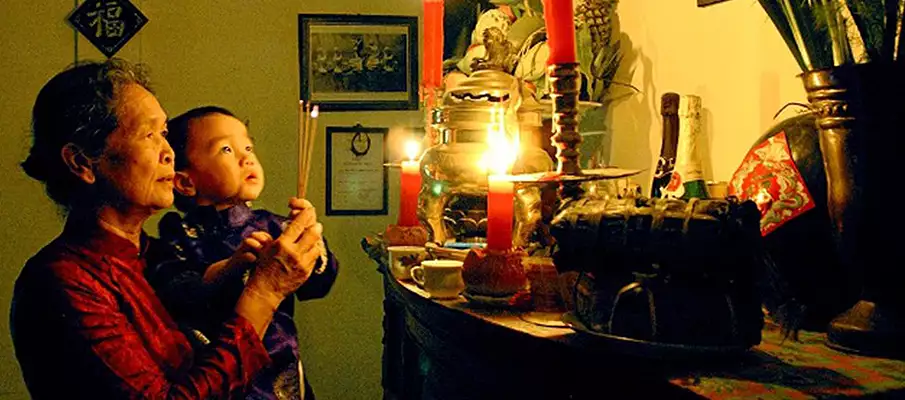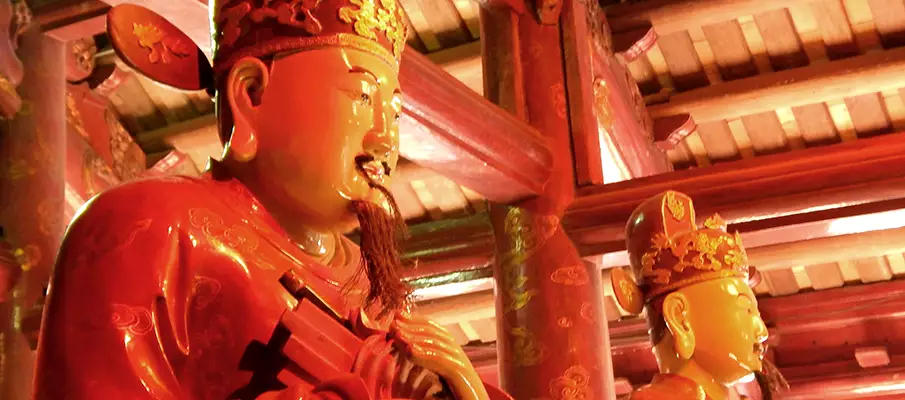
Quick answer: Vietnam’s spiritual life is deeply rooted in syncretism: many people combine ancestor worship, folk beliefs, and formal religions like Buddhism, Christianity, and local faiths. The country officially recognizes many religions, and traditional practices like worshipping village deities and ancestors remain central to Vietnamese culture.
At a glance:
- 🧠 Folk Religion: Ancestor worship and local deities are widespread and deeply embedded in daily life.
- 🛕 Buddhism: One of the most practiced religions — both Mahayana and Theravada traditions.
- ✝️ Christianity: Catholicism and Protestantism have a significant presence, introduced during colonial times.
- 🔯 Caodaism: A uniquely Vietnamese monotheistic religion blending Buddhism, Confucianism, Taoism, and Christianity.
- ☸️ Hoa Hao Buddhism: A reformed, simpler Buddhist tradition focused on home practice and moral living.
- 🕌 Islam & Hinduism: Small communities, mainly among Cham ethnic groups.
- 🌐 Baha’i Faith: Recognized and practiced, though by a smaller number.
Last updated in November 2025
Religion in Vietnam: A Colorful Mosaic of Faith and Tradition
A country where spirituality permeates everyday life
Vietnam is not only a land of stunning nature, fascinating history, and rich cuisine – it is also a place where spirituality intertwines with every aspect of life. From rural villages to bustling cities, from mountain regions to fertile deltas – faith and religion are present in prayers, rituals, household altars, hilltop temples, and festive celebrations. Here, religion is not seen merely as a formal institution but as a living part of culture, identity, and the moral fabric of every Vietnamese person.
A history shaped by many influences
Over the millennia, Vietnam’s spiritual landscape has been shaped by many civilizational currents – particularly Chinese, Indian, and later European cultures. Chinese rule brought Confucianism, Taoism, and Mahayana Buddhism to the country. India especially influenced the south and various ethnic minorities, where Theravāda Buddhism took root. And European colonial powers, especially France, left a significant legacy through the spread of Christianity, particularly Catholicism.
A vibrant spiritual mosaic today
Today’s Vietnam is a spiritual mosaic in which different religions often coexist peacefully and sometimes even intermingle. It’s not uncommon for people to venerate Buddha, ancestors, and Taoist deities simultaneously, while also celebrating Christmas as a social event. This flexibility and tolerance create a harmonious whole that is characteristic of Vietnamese religious practice.
A spiritual identity rooted in everyday life
Although most Vietnamese people do not formally identify with a specific religion – and statistics may give a misleading impression – spiritual practices such as ancestor worship, visits to pagodas, prayers, offerings, and festivals play an important role in the lives of the vast majority. Faith here is not expressed flamboyantly but quietly and respectfully – it is part of daily rituals, ethical decisions, and family traditions.
Book a Tour / Excursion in Vietnam ➜
Overview of Major Religions in Vietnam:
1. Folk Religion and Ancestor Worship (Đạo ông bà)
Folk religion is the most widespread spiritual practice in Vietnam. It is not an organized religion in the traditional sense, but rather a complex of customs, rituals, and beliefs that combine ancestor worship with reverence for local deities, nature spirits, and heroes of the past.
-
- Ancestor worship is a key element of Vietnamese identity – almost every household has a home altar with photos of deceased family members, offerings, and incense sticks.
- It is believed that ancestors continue to influence the lives of their descendants and can bring both blessings and misfortune.
- This form of worship is often practiced alongside elements of Buddhism and Taoism.

2. Buddhism (Phật giáo)
Buddhism is one of the most important religions in Vietnam. Its Mahayana form was introduced as early as the 2nd century AD via China from India. In Vietnam, Buddhism has developed not only as a religion but also as a philosophy and way of life that influences ethics, thinking, and daily habits.
In the northern and central regions, Mahayana Buddhism predominates, while in the south, Theravāda Buddhism is widespread, especially among the Khmer minority. Thus, Buddhism remains an important part of Vietnamese culture and spirituality.
-
- Mahayana Buddhism dominates in northern and central Vietnam.
- Theravāda Buddhism, prevalent in southern Vietnam, is particularly significant for the Khmer minority in the Mekong Delta.
- Famous Buddhist landmarks include Thiên Mụ Pagoda in Huế, Bái Đính Pagoda in Ninh Bình, and Trấn Quốc Pagoda in Hanoi.

3. Confucianism (Nho giáo) and Taoism (Đạo giáo)
These two philosophical schools, adopted from China during over a thousand years of Chinese rule, played a key role in shaping Vietnamese culture, value systems, education, and state administration. Confucianism emphasized morality, respect for authority, family relationships, and education, which particularly influenced the elite and the structure of governance.
Taoism, on the other hand, introduced elements of mysticism, the worship of natural forces, and a belief in harmony between humans and the universe. This was reflected in folk rituals, traditional healing, and a view of life’s balance. Both schools gradually merged with local traditions and are still evident in daily life, especially in rural areas and spiritual practices.
-
- Confucianism emphasizes moral values, respect for authority, and education. Its main symbol is the Temple of Literature (Văn Miếu) in Hanoi.
- Taoism is more associated with mysticism, natural harmony, and spiritual practices. In some areas, it blends with folk religion, for example in the worship of mountain and water spirits.

4. Christianity
Christianity in Vietnam appeared in the 16th century thanks to Portuguese Jesuits, but it spread more significantly during the French colonial era. Catholicism received support from France, leading to the construction of the first churches and religious institutions. A key historical figure was Alexandre de Rhodes, who contributed to the development of the Latin-based Vietnamese script (quốc ngữ).
Today, Christianity – especially Catholicism – holds a strong position, particularly in southern Vietnam. Protestant churches are mainly present among some ethnic minorities in mountainous regions. Christianity is now an important spiritual force and a cultural element in many communities.
Catholicism (Công giáo)
-
- Represents about 7–8% of the population.
- The highest number of believers live in provinces such as Nam Định, Ninh Bình, Thanh Hóa, and in the Ho Chi Minh City area.
- Significant landmarks include the Notre-Dame Cathedral in Ho Chi Minh City and Phát Diệm Cathedral in the north-central region.
Protestantism (Tin lành)
-
- Growing particularly among ethnic minorities in the mountains (e.g., the Hmong or Ede people).
- Mainly spread in central and northwestern provinces.
5. Islam (Hồi giáo)
Islam in Vietnam is practiced mainly by the Cham (Chăm) community, one of the most prominent ethnic minorities in the country. The Chams have a rich history and culture dating back to the Champa Kingdom, which was a significant maritime power in Southeast Asia. Islam spread among the Chams primarily through contact with Arab, Malay, and Indonesian traders and missionaries over the centuries.
Today, most Vietnamese Muslims live in the provinces of Ninh Thuận and An Giang in the south, where local mosques serve as centers of both religious and community life. Cham Islam features unique characteristics often blended with local customs and traditions, creating a distinctive expression of the faith. Although the Muslim population makes up a relatively small portion of Vietnam’s population, their cultural and religious contributions are notable and increasingly visible.
-
- Cham Muslim communities preserve their religious traditions, have their own mosques, and celebrate festivals such as Hari Raya.
- Islam in Vietnam is peaceful and community-oriented, emphasizing harmony and coexistence.
6. Hoa Hao and Cao Dai – Religions Originating in Vietnam
Vietnam is also home to two unique religious movements that originated within its borders and reflect the local spiritual and cultural needs: Hòa Hảo and Cao Đài.
-
- Hòa Hảo emerged in the 20th century in southern Vietnam as a reform Buddhist movement founded by Ngô Minh Chiêu. This religion emphasizes simplicity, humility, and a direct relationship between the individual and God without the need for complex rituals or temple hierarchies. Hòa Hảo stresses moral purity, family values, and community cohesion, making it a significant spiritual force particularly in the rural areas of the Mekong Delta.
-
- Cao Đài, on the other hand, is a syncretic religion founded in 1926 in southern Vietnam, combining elements of Buddhism, Christianity, Taoism, Confucianism, and Islam. Its followers worship God as the supreme being while also honoring prophets and spiritual teachers from various religious traditions. Cao Đài has a well-organized ecclesiastical structure, distinct temple architecture, and a wide range of rituals. It is a major part of the spiritual life in southern Vietnam, attracting millions of followers.

Religious Holidays and Celebrations in Vietnam:
-
- The Vietnamese celebrate a number of religious holidays, many of which overlap with cultural events:
- Tết Nguyên Đán (Lunar New Year) – the most important holiday of the year, associated with ancestor worship.
- Vu Lan (Ghost Festival) – a Buddhist holiday honoring parents and ancestors, similar to All Souls‘ Day.
- Lễ hội chùa Hương – a pilgrimage festival to the Perfume Pagoda, located about 60 km from Hanoi.
- Noel (Christmas) – celebrated not only by Christians but also in a secular way across the country.
Interesting Facts and Spiritual Uniqueness in Vietnam:
-
- Vietnam is one of the few countries in the world where the three main Eastern philosophical traditions – Confucianism, Taoism, and Buddhism – blend together. This trio is often referred to as „tam giáo đồng nguyên“ (three religions in unity).
- Pagodas are not only places of worship but also cultural and historical landmarks – they often host weddings, rituals, and folk festivals.
- The Vietnamese government officially recognizes 16 religious organizations, even though the communist regime historically limited religious expression.
- Unofficially, religious life is highly diverse and decentralized, with many people practicing a combination of traditions – it is typical to “be a Buddhist, believe in spirits, and worship ancestors.”
Conclusion: Religion as a Key to Understanding Vietnamese Society
Religion in Vietnam is not merely a matter of faith – it is deeply rooted in the structure of society, family relationships, everyday life, and national culture. Its unique fusion of traditional and modern influences, as well as domestic and foreign inspirations, creates a fascinating spiritual landscape that is as diverse as Vietnam itself.
If you’re planning to visit Vietnam, it’s worth visiting at least one pagoda, participating in the Tết holiday, and asking locals about their beliefs – you’ll gain not only valuable cultural insight but also a deeper understanding of a country that lives in harmony with many spiritual worlds.
| Region | Dominant Religious Traditions |
|---|---|
| Northern Vietnam | Mahayana Buddhism is the most influential spiritual path in this region, often intertwined with Confucian teachings that emphasize respect for hierarchy, education, and social harmony. Ancestor worship is deeply ingrained in daily life, with family altars found in most homes and rituals regularly performed to honor deceased relatives. |
| Central Vietnam | This region reflects a diverse spiritual tapestry. Mahayana Buddhism remains strong, particularly in cultural centers like Huế. Catholicism, brought by French missionaries, also has a visible presence. Taoist influences, especially in folk healing and spiritual rituals, are woven into local traditions and festivals. |
| Southern Vietnam | Southern Vietnam is religiously diverse and dynamic. Catholicism is especially prevalent here, with large and active congregations. The region is also the birthplace of Cao Đài and Hòa Hảo—two indigenous religions that integrate traditional and modern beliefs. Protestantism has also grown, particularly among some ethnic minorities and urban communities. |
| Mekong Delta | This area is notable for its Theravāda Buddhist communities, especially among the Khmer ethnic minority. Hòa Hảo Buddhism has deep rural roots here and shapes the social and spiritual life of many villages. The Cham Muslim community also resides in this region, maintaining their faith and traditions through mosques and community events. |
| Mountainous Areas | In Vietnam’s highland regions, Protestant Christianity has gained traction, particularly among ethnic minorities such as the Hmong, Ede, and Jarai. These communities often blend Christian teachings with their traditional customs, forming unique expressions of faith shaped by both spiritual heritage and missionary influence. |
Book a TOUR / TRIP in Vietnam ➜




